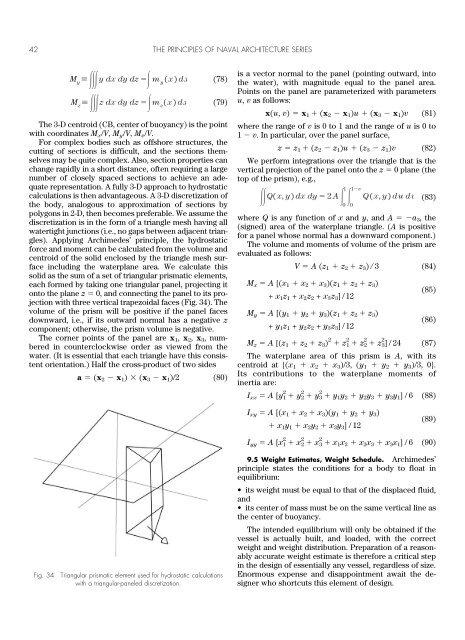The Geometry of Ships
Create successful ePaper yourself
Turn your PDF publications into a flip-book with our unique Google optimized e-Paper software.
THE GEOMETRY OF SHIPS 41<br />
Alternatively, we could choose P 0 and Q x; then<br />
(63)<br />
Often the boundary C can be approximated as a<br />
closed polygon (polyline) P <strong>of</strong> N segments C i , i 0,...N<br />
1, connecting points x i , i 0,...N 1, where each x i<br />
is a two-component vector {x i , y i }. (<strong>The</strong> last segment<br />
connects point x N1 back to point x 0 .) <strong>The</strong> line integral<br />
equation (63) becomes a sum over the N straight<br />
segments:<br />
(64)<br />
Segment i runs from x i1 to x i ; it can be parameterized<br />
as x i1 (1 t) x i t, with 0 t 1; i.e.,<br />
x x i1 (1 t) x i t, (65)<br />
y y i1 (1 t) y i t (66)<br />
so dy (y i y i1 )dt. Thus the contribution from C i is<br />
A i<br />
<br />
<br />
1<br />
0<br />
A <br />
N<br />
<br />
i1<br />
<br />
R<br />
(x i1<br />
x i<br />
)(y i<br />
y i1<br />
)/2<br />
(67)<br />
and this allows the enclosed area A to be easily computed<br />
as the sum <strong>of</strong> N such terms.<br />
Note that the polygonal region R cannot have any interior<br />
holes because its boundary is defined to be a single<br />
closed polygon. However, polygonal holes are easily<br />
allowed for by applying the same formula [equation (67)]<br />
to each hole and subtracting their areas from the areas<br />
<strong>of</strong> the outer boundary.<br />
This same general scheme can be applied to compute<br />
integrals <strong>of</strong> other polynomial quantities over arbitrary<br />
polygonal regions. <strong>The</strong> first moments <strong>of</strong> area <strong>of</strong> R with<br />
respect to x and y are defined as<br />
{m x<br />
, m y<br />
} <br />
(68)<br />
<strong>The</strong>se have dimensions <strong>of</strong> length cubed. m x can be<br />
put in the form <strong>of</strong> Green’s theorem by choosing Q 0<br />
and P xy; then<br />
m x<br />
<br />
(69)<br />
Similarly, m y can be put in the form <strong>of</strong> Greens’s theorem<br />
by choosing Q 0 and P y 2 /2; then<br />
m y<br />
<br />
dx dy<br />
A A i<br />
where A i<br />
<br />
[x i1<br />
(1t)x i<br />
t](y i<br />
y i1<br />
)dt<br />
<br />
<br />
<br />
R<br />
<br />
x dy<br />
R<br />
{x, y} dx dy<br />
xy dx<br />
R<br />
y 2 /2dx<br />
R<br />
<br />
C i<br />
xdy<br />
(70)<br />
Replacing the boundary with a polygon as before, the<br />
x- and y-moments <strong>of</strong> area are:<br />
m x<br />
<br />
(71)<br />
(72)<br />
<strong>The</strong>re is a need for some purposes to compute moments<br />
<strong>of</strong> inertia <strong>of</strong> plane regions. Moments <strong>of</strong> inertia<br />
with respect to the origin are defined as follows:<br />
(73)<br />
<strong>The</strong>se have units <strong>of</strong> length to the fourth power.<br />
Application <strong>of</strong> Green’s theorem and calculations similar<br />
to the above for an arbitrary closed polygon result in:<br />
I xx<br />
<br />
I xy<br />
<br />
I yy<br />
<br />
N<br />
<br />
i1<br />
N<br />
<br />
i1<br />
N<br />
<br />
i1<br />
N<br />
<br />
i1<br />
N<br />
<br />
i1<br />
(x i<br />
x i1<br />
)(2y i1<br />
x i1<br />
{I xx<br />
, I xy<br />
, I yy<br />
} <br />
(x i<br />
x i1<br />
)(y 3 i1 <br />
(x i<br />
x i1<br />
)(3x i1<br />
y 2 i1<br />
x x i1<br />
y 2 i<br />
y 2 i1 2x i1 y i1 y i<br />
i <br />
(x i<br />
x i1<br />
)(3x 2 i1 y i1<br />
x2 i1 y i 2x i1 x i y i1 x2 i y i1 <br />
(74)<br />
(75)<br />
(76)<br />
<strong>The</strong> centroid (center <strong>of</strong> area) is the point with coordinates<br />
m x /A, m y /A. Note that the centroid is undefined<br />
for a polygon with zero enclosed area, whereas the moments<br />
are always well defined. This suggests postponing<br />
the division, de-emphasizing section centroids, and performing<br />
calculations with moments as far as possible,<br />
especially in automated calculations where attempting a<br />
division by zero will either halt the program or produce<br />
erroneous results.<br />
For example, there is generally no need to calculate<br />
the centroid <strong>of</strong> a section. <strong>The</strong> 3-D moments <strong>of</strong> displaced<br />
volume for a ship are<br />
M x<br />
<br />
2x i1<br />
x i<br />
y i<br />
3x 2 i y i )/12<br />
<br />
y i1<br />
x i<br />
y i<br />
x i1<br />
2y i<br />
x i<br />
)/6<br />
m y<br />
(x i<br />
x i1<br />
)(y 2 i1 y i y i1 y2 i )/6<br />
{y 2 ,xy,x 2 } dx dy<br />
R<br />
y 2 i1 y i y i1 y2 i y3 i )/12<br />
2x i<br />
y i1<br />
y i<br />
3x i<br />
y 2 i )/24<br />
xdxdydz xS(x) dx<br />
<br />
(77)



